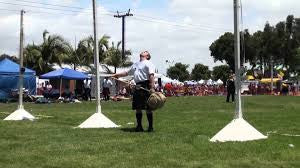It seems one of the most hated (and loved) events in the Heavy Events is the one that isn't necessarily a part of the historical Heavy Events: the Sheaf Toss. You see, it's originally a North American addition to the games. The genesis of this event is unclear, whether it was because we North American farm boys can really chuck a bale of hay or that we wanted to get the upper hand on the Scots in an event they were unfamiliar with. Who knows? But, if you've jumped into this sport, then you know the love/hate relationship many athletes have with this event. Depending on the region of the US you throw in (or overseas athletes, too) you may or may not even see this event! But, whether you throw this crazy thing on a weekly basis or only see it once a year, it's best to have a general grasp on the basics. We'll dive into some of the actual throwing of it later, but, for today, let's break down a few basics that you may already know or that you might consider tweaking on your set up and approach.
Grab a Fork (both the "food" type and the "pitch" type)
Now, I'm gonna go ahead and tell you, there's an age old debate revolving around whether a two-tine or three-tine fork is best. In my opinion, if you're throwing a 20 lb. sheaf, you're better off with a three-tine. It seems the two-tine works great for the 16 lb. given it is lighter and doesn't bend the tines as much. Personally, I think the three-tine is a better choice in the long-run. I am not about to tell you to steer clear of a two-tine; throw with what you're comfortable with.
If you're just starting in the sport, there seems to be a special bond between the thrower and the fork. Now, not always, but many throwers like to customize and “trick out” their forks. With that said, I suggest you find a fork you like and get your reps in with it. Wood handle, metal handle, two-tine, three-tine, four-tine modified into three ... it doesn’t matter. Just throw!
So, now that you’ve selected (and possibly even named) your fork, let’s get to the grip.
Grip It and Rip It (I used to love that energy drink)
I’m right handed, so I grab the fork end with my left hand and the end of the handle with my right hand. How you hold that fork isn’t necessarily specific, as it changes with the type of fork you are using. Just make sure you have a solid grip on the fork, as that is your “pulling” hand. The hand I’m more concerned about is the hand you hold the handle with. Make sure your hand is outside your shoulder width; I like to make my grip width like that a of a snatch grip. This serves me a few purposes, but, mostly so that the bag isn’t as likely to drag the ground on my throw, and, again, closely resemble the hold and motion of a hang snatch movement.
Step Out
Like we covered in the weight over bar, a consistent distance away from the bar is critical in this event. If you don’t have uprights to practice on, you can still measure out your distance and prepare for competition. Simply drag a line in the grass with your foot. From there, measure out your steps. When you get to competition, do the same thing, only drag your line in conjunction with the cross bar. It’s a tiresome cliché, but consistency is key. Taking consistent steps away from the bar takes one variable out of the throw, allowing you to focus on the true technique of the event and not if you’re, “peaking in front” or “behind” the bar. With a consistent distance, you can quit worrying about your peak and focus more on the backswing, drive down, “checkmark,” block and finish … but, more on that to come.

